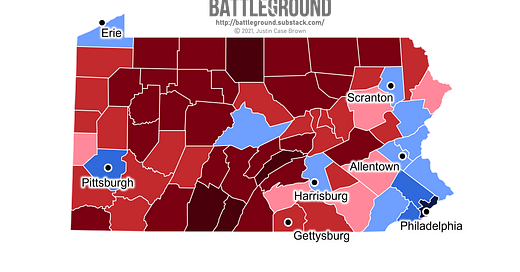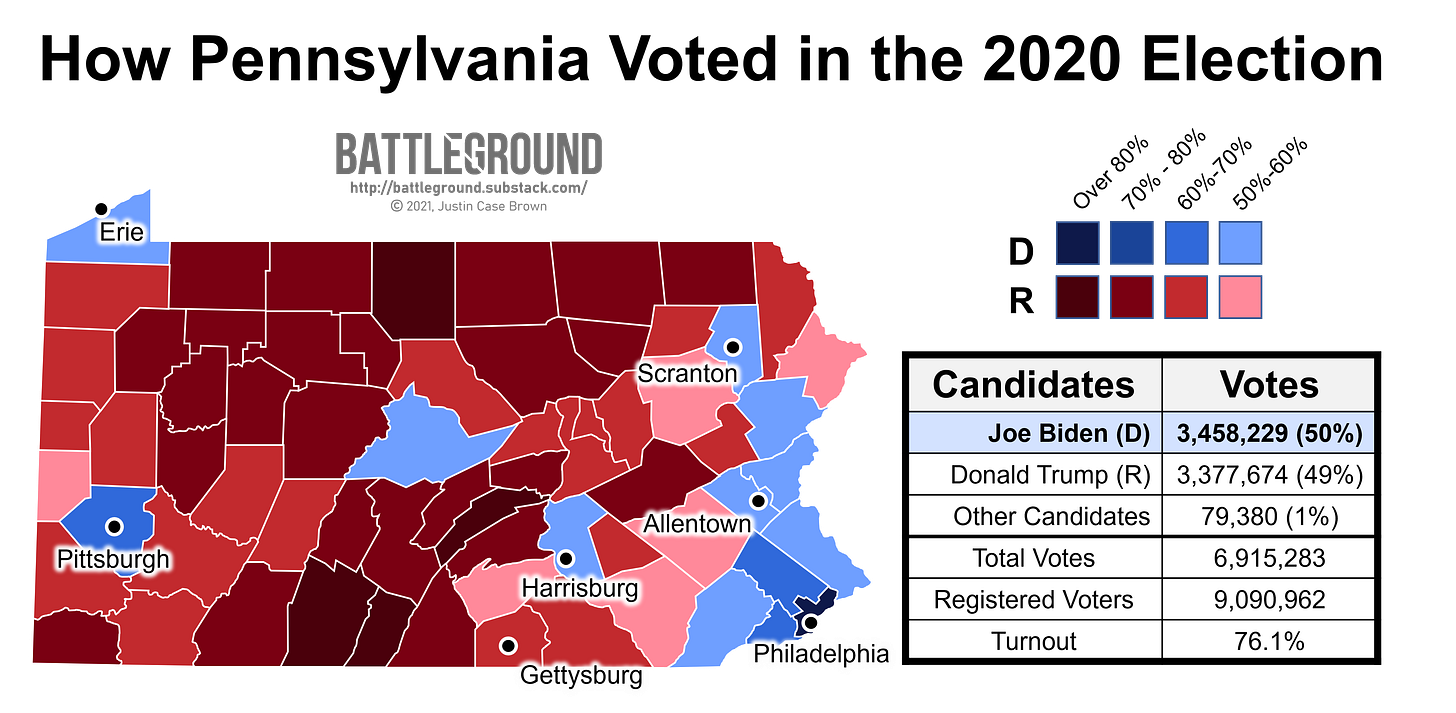Pennsylvania: Valley Voters v. Pennsyltucky
Not many Pennsylvanians were happy with their options in 2020. (Not even in Happy Valley.)
Topline Takeaways
Joe Biden recaptured Pennsylvania for Democrats by building on Clinton’s margins in over 20 counties across the state.
Donald Trump’s narrow loss can largely be chalked up to self-imposed errors; many voters specifically cited their displeasure with his presidency as the reason why they turned out to vote.
Split ticket voting was prevalent in this election as Joe Biden won the presidency but Republicans increased their vote margin in House races by nearly 5 points when compared to the 2018 midterms.
Valley Voters
Joe Biden was able to recapture Pennsylvania for Democrats by regaining previously disaffected voters in many of the state’s valleys: the Delaware Valley, home to Philadelphia; the Lehigh Valley, home to Allentown; and the Wyoming Valley, home to Scranton.
For decades the Wyoming and Lehigh Valleys were home to a largely white, older electorate. The towns in these areas relied heavily on an industrial-focused economy known for its steel and coal production. In the wake of Trump’s win in 2016, these places were often characterized as forgotten towns where job opportunities were scarce. Recently, this narrative has been challenged as many towns in the region are seeing demographic changes with their populations diversifying as the amount of younger residents increases. Those changes helped give a slight nudge to Joe Biden and hampered Trump’s campaign.
In the Delaware Valley, voters supported Biden but not necessarily Democrats as a party. While he managed to garner the necessary support in the populous suburbs of Philadelphia to overcome Trump, it didn’t translate to votes for congressional Democrats down the ballot. Voters very clearly voiced their displeasure with Trump, not necessarily their support of the Democratic Party’s message.
“It was more of a vote against President Trump than for Biden.” -Jeff Matthes, voter in Bucks County
Pennsyltucky
Trump’s base of support largely fell in the traditionally Republican, rural counties between the state’s two major metropolitan areas. When consulting rural voters, Trump’s problem in Pennsylvania this time around was that his opponent wasn’t quite as unfavorable as in 2016. Andy Szekeresh, a voter in Cambria county explains, “The country wasn’t ready for a lady president like that. [Biden is] OK. It’s just, we need a change and a new president, that’s all.” He narrowly came out ahead in Pennsylvania’s Dutch Country, the counties lying between Philadelphia and the state capital Harrisburg. Although voting among the Amish “has never been widespread,” those who do vote tend to support Republicans as they share strong religious beliefs and largely favor small government policies. While Trump was favored by the Confederate flag-waving constituency found in rural Pennsylvania (yes, this idiotic bloc of voters does exist), his time as president has garnered him more opponents than supporters within Pennsylvania. While the counties he won saw slightly higher turnout than those won by Biden, many Biden voters specifically cited Trump as the reason for casting their vote.
Forecasting the Future: Despite Democratic success at the top of the ticket, no House seats flipped parties, proving that many Pennsylvania voters rejected Donald Trump but not the Republican party as a whole. The most consistent message from voters was a search for moderates. Many in rural areas voiced their displeasure with Democrats’ hard-line approach to pandemic safety measures, (One voter’s response to the governor’s mask-mandate: “that ain’t never happening.”) while many in the suburbs chafed at the thought of seeing Trump wield the bully pulpit for another four years. The path forward in Pennsylvania’s upcoming elections seems to be paved for candidates like Rep. Conor Lamb, a Democrat who’s succeeded at keeping a rural electorate in his corner by calling out the bombast of his opponents and keeping his message on kitchen table issues that directly affect voters.






